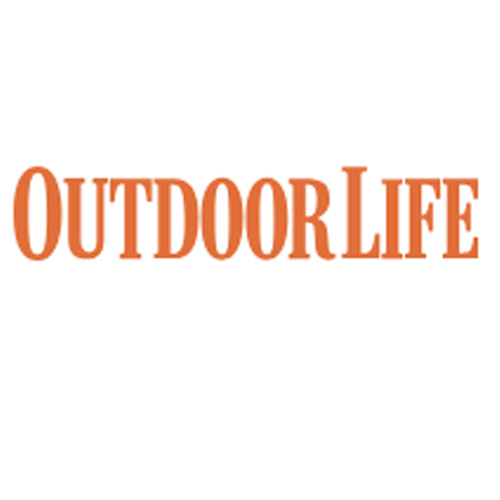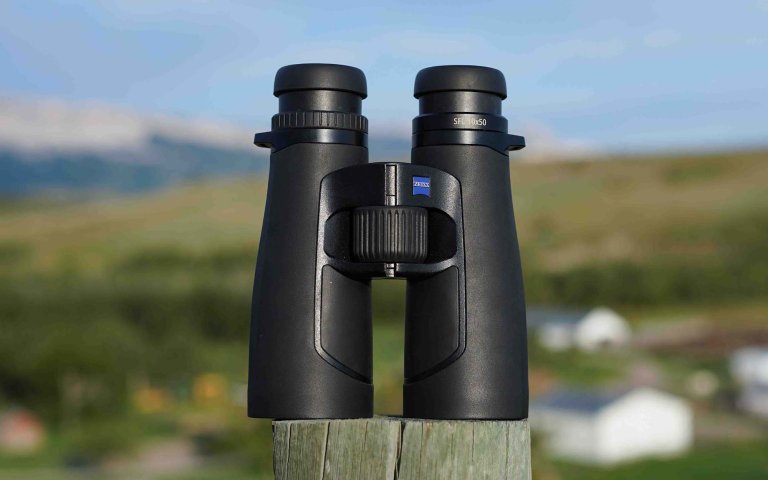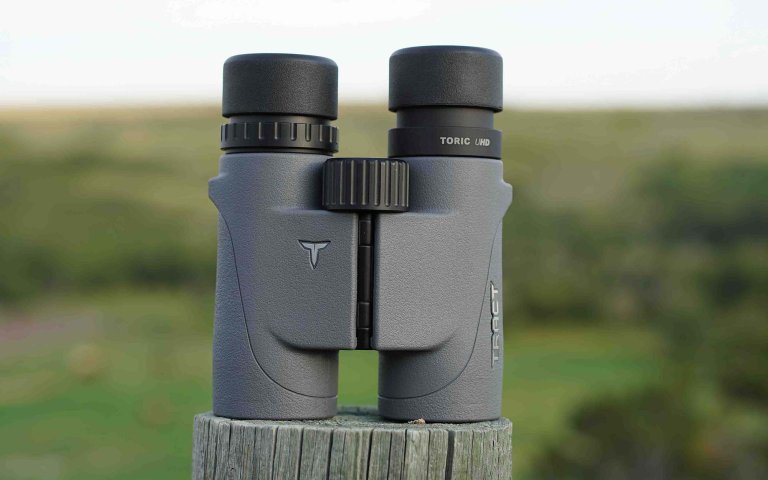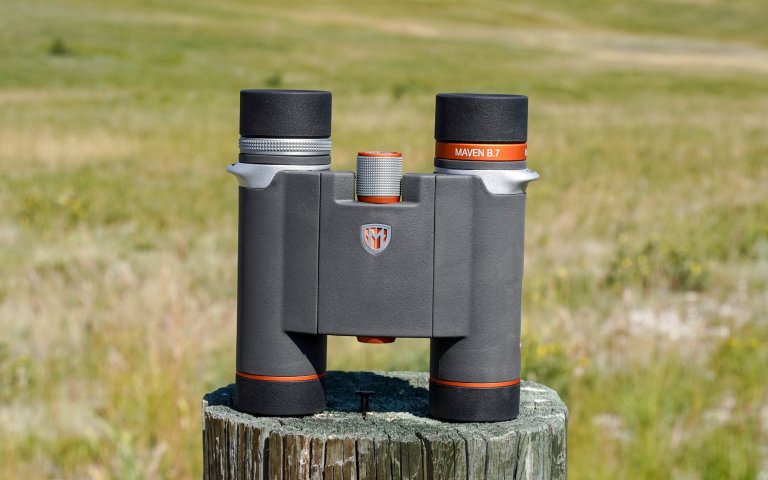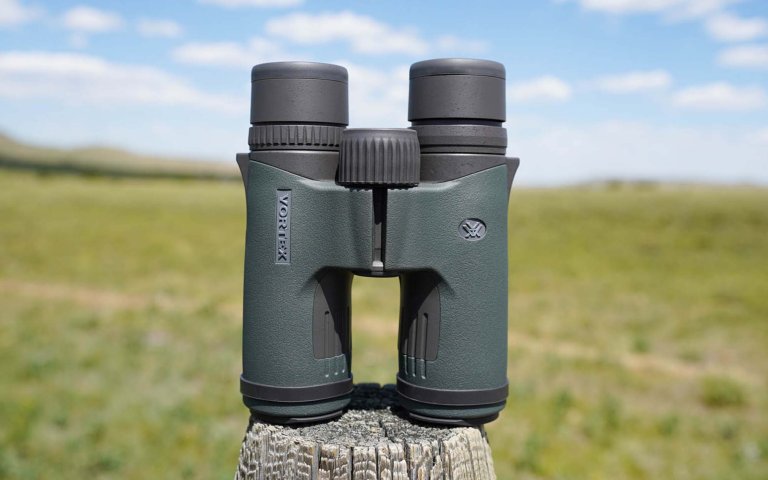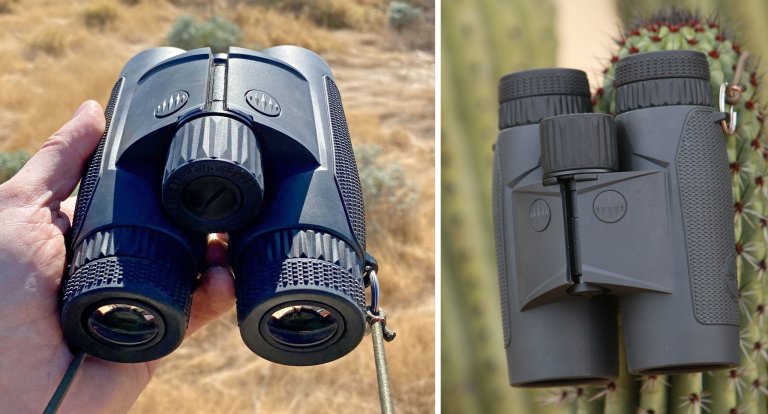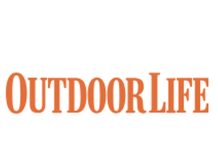It doesn’t matter if you’re hanging from a saddle in big woods or sneaking through the orchard grass along the Milk River, every whitetail hunter can benefit from good glass. We’ve tested just about every binocular on the market at our annual optics test. Here are the top options for deer hunters.
- Buy Once Cry Once: Zeiss SFL 10×50
- Best Value: Tract Toric UHD 8×32
- Best Cheap Bino: Vortex Triumph HD 10×42
- Best Pocket Size: Maven B.7 8×25
- Best Compact: Vortex Razor UHD 8×32
- Best Rangefinding Binocular: Leupold BX-4 Range 10×42
Buy Once Cry Once: Zeiss SFL 10×50
Pros
- 10×50 performance in 10×42 frame
- SmartFocus fast-turning focus wheel
- Light for configuration
Cons
- At nearly $1,800, expensive
- Requires larger bino harness pouch
Key Features
-
Open-barrel, dual-hinge design -
Right-barrel diopter -
Oversized focus wheel -
¼-20 tripod adapter -
Magnesium housing -
Lifetime transferable warranty
A year after Zeiss introduced its SFL binocular in 8×40 and 10×40 versions, the German brand has achieved a pinnacle accomplishment with 10×50 and 12×50 models in the line, delivering 50mm performance in a 42mm-sized chassis.
The result is a powerful, bright, and extremely well-balanced binocular that is optimized for hunters and birders who value walk-about size and weight but want a little more optical horsepower than a standard 10×42.
The combination of excellent glass, a responsive and tactile focus wheel, excellent ergonomics, and what we consider a fair price for a premium optic earned the Zeiss SFL our consensus pick for Editor’s Choice as the top binocular of 2025. While the award goes to the 10×50 SFL, Zeiss’s 12×50 SFL accrued nearly the same score.
Both binoculars achieve their compact frame and relatively light weight through a redesigned optical prescription that uses thinner, lighter lenses stacked relatively close together in the magnesium chassis. The result is a 6.3-inch binocular that weighs just under 31 ounces. Those dimensions are standard for 10×42 binoculars, but the Zeiss models give users 18 percent more magnification (in the 12x version) and a significantly larger exit pupil in both versions, delivering more light to users’ eyes and contributing to overall image brightness compared to 10×42 binoculars. The 50mm objective lens, with 42 percent more surface area than a 42mm, is similarly capable of delivering significantly more light to the eye.
Manufactured in Japan, the Zeiss’s glass is excellent, with no observed edge distortion or flaring, and testers noted the vivid color rendition and remarkable image brightness.
“A do-it-all, take-it-anywhere piece of gear for hunters, wildlife watchers, spectators, etc.,” noted tester Luke Coccoli.
And tester Ky Idler, who noted some stickiness in one eye cup and some tooling marks in the interior of one barrel, said “The glass is clear. I would not be afraid to glass with this for hours. Zeiss nailed it.”
The open-barrel build and light weight enables one-hand operation, and the balance is excellent, settling in both hands without feeling forward heavy. The fast-focus wheel is especially useful, even under gloved fingers. In fact the SFL naming convention comes from Zeiss’s term for this control: the very Germanic SmartFocus Concept. The oversized focus wheel turns from close focus of 6 feet to infinity in just 1.4 turns of the wheel.
The rest of the unit has the features you’d expect: a good tripod mount on the front hinge, right-barrel diopter control, and three-position eyecups. The SFL is covered by a transferable warranty.
Of the two units we tested, I prefer the 10×50. The wider field of view makes images seem more panoramic, and the 12×50 version has just a little hand-shake unless I lock my elbows in. But for users who stabilize their binos on a tripod or other support, the 12×50 offers just a little bit more reach with the same vibrant, bright image.
With the addition of the 50mm models, Zeiss’s SFL line now includes an 8×30, 10×30, 8×40, 10×40, 8×50, 10×50, and 12×50.
The 10×50 and 12×50 SFL models retail for $1,799 and $1,999, respectively. It’s an investment, for sure, but we think between the optical performance, ergonomics, and disruptive design, the Zeiss SFL is an heirloom-grade binocular that will produce years of satisfying viewing.
| Zeiss SFL 10×50 Specs | |
| Magnification: | 10-power |
| Objective Lens: | 50mm |
| Light Transmission: | 90 percent |
| Exit Pupil Diameter: | 5.0mm |
| Twilight Factor: | 22.4 |
| Field of View: | 366 feet at 1,000 yards |
| Close Focus: | 5.9 feet |
| Weight: | 30.8 ounces |
| Length: | 6.3 inches |
Best Value: Tract Toric UHD 8×32
Pros
- Tight and durable build
- Bright Schott high-transmission glass
- Light at 23 ounces
- Easy one-hand operation
- Tight and positive controls
- Lifetime warranty
Cons
- Relatively expensive for a compact bino
- Slight blue edge aberration
Key Features
-
Closed-bridge design Locking right-barrel diopter -
Front-hinge ¼-20 tripod thread -
Magnesium-alloy chassis -
3-position eyecups -
Easy one-hand operation
Calm down, settlers. I hear your roars of discontent that we have named a $644 compact binocular an Outdoor Life Great Buy. That’s a lot of money for relatively little glass. But hear me out. First, there wasn’t a lot of competition for the award this year. There were cheaper submissions, but they were optically inferior to this bright, tight little unit. And this binocular from a direct-to-consumer company punches way above its size. Add the lifetime warranty and versatility from whitetail stands to turkey vests to every truck console in America, and this is the binocular you will reach for above all others.
We’ve tested the big brothers of the 8×32 in previous tests, but this configuration hits a sweet spot. Its image seems like it was delivered by a big 10×42, but the small frame of the 8×32 fits in places the larger chassis doesn’t.
Then there’s the tight build of the Toric. Those who have followed the evolution of Tract Optics know one of its distinctive features is smooth, positive, extremely tactile controls. Scope turrets move with smooth precision and binocular eyecups feel like they glide on ball-bearing races. Those controls extend to the focus wheel, locking diopter control, and eyecups of this smallish binocular.
The detail that cemented the Great Buy award for the Tract Toric is its lifetime warranty. I doubt you’d ever use that coverage, but it’s useful to know that you have a binocular for life. In the field, you’ll use it for a one-handed spot-and-stalk bowhunting optic. You’ll have it in your bino pouch for turkey hunting or hiking. Or you’ll throw it in your luggage for a travel optic.
Testers subtracted points for a fairly clunky build and some blue color fringing. Testers who gravitate toward full-sized 10×42 binos thought the compact Tract was underwhelming.
“My first impression was that I didn’t want to like this binocular,” noted tester Ky Idler. “But surprisingly it fit my hands. Good glass. It would be a very good spot-and-stalk binocular.”
The Tract seems bigger than it is largely because of its excellent glass. It’s built around high-transmission Schott glass, manufactured in Japan, and has a wide field of view. Normally, I like open-barrel designs for one-hand operation, but the closed-bridge build of the Toric, while a little center-weighted, has enough heft that it settles in hand, whether one hand or two.
I’d readily use this binocular for bowhunting, when single-hand operation is required and where positive focus control helps parse close, medium, and far range targets. The Tract capably handles this chore with aplomb, if not distinctive style.
Maybe this helps answer the question: Is $644 too much to pay for a quality compact binocular? In the case of the Tract Toric UHD, the answer is decidedly no. While I’m not eager to pay more, this is a solid deal for a very good and versatile hunting optic.
| Tract Toric UHD 8×32 Specs | |
| Magnification: | 8-power |
| Objective Lens: | 32mm |
| Light Transmission: | Not provided |
| Exit Pupil Diameter: | 4.0mm |
| Twilight Factor: | 16 |
| Field of View: | 424 feet at 1,000 yards |
| Close Focus: | 6.5 feet |
| Weight: | 23 ounces |
| Length: | 5.2 inches |
Best Cheap Bino: Vortex Triumph HD 10×42
Pros
- Ships with excellent GlassPak harness
- Light
- Extremely accessible real-world street price of under $100
Cons
- Significant peripheral distortion
- Flimsy feeling
Score Card
-
Optical Performance:
Fair -
Mechanical Performance:
Good -
Design:
Good -
Price/Value:
Very Good
Key Features
-
Single-hinge, closed-bridge design -
Roof-prism design -
Right-barrel diopter control -
Fully transferable lifetime warranty -
Tripod adaptable -
Weight:
22.9 ounces -
Price:
$99
How on earth can Vortex bring a capable binocular to the masses for under $100? With a good bino harness and the brand’s legendary warranty? Those were questions our test team batted around as we handled this entry-level binocular. Then we got behind the lenses and learned some of the answers.
The biggest answer is the class of glass inside the new Triumph HD is cheap. The Vortex received uniformly downbeat assessments in optical performance; it scored near the bottom in low-light brightness, and its resolution score was just below the median. Testers further complained about blue color fringing, noticeable edge distortion, and blurry focus.

But we also recognized that you shouldn’t expect world-beating glass inside a $99 binocular, and that same realism pervaded our assessment of the Triumph’s mechanical performance. The diopter adjustment is stickier than we’d like, and the overall build feels flimsy. But the tapered eyecups move with positivity and the focus wheel is tight and responsive. The texturing, balance, and overall design is better than we’d expect for the price.
On the value side of the ledger, the GlassPak case and integrated harness confirms the best value designation we gave the Triumph HD. This would make a very good first optic for a hunter, birder, or shooter, and if treated gently is a good choice to throw in a pickup or cabin. We’re not sure how much rough handling this bino can take, but Vortex’s excellent warranty and customer service is a cheering consolation.
Read Best Binoculars for the Money to see more high-value binoculars. Or read our full Vortex Triumph HD review to learn more.
Best Pocket Size: Maven B.7 8×25
Pros
- Highly textured focus and diopter controls
- Excellent treestand or turkey-vest optic
- Distinctive orange accents
Cons
- Too small for open-country glassing
- Controls hard to manipulate with gloves
Score Card
-
Optical Performance:
Good -
Mechanical Performance:
Very Good -
Design:
Very Good -
Price/Value:
Good
Key Features
-
Double-hinge, closed-bridge design -
Right-barrel diopter control -
Extra-low-dispersion glass -
Extremely compact design -
Also available in 10×24 -
Weight:
12.4 ounces
With this petite binocular, introduced earlier this year, Maven is well on its way to filling out its product line. The B.7 is a compact version of the direct-to-consumer company’s excellent B.3 line.
It should be said at the outset that this is a fairly specialized optic. It’s configured for portability and use in tight quarters and in close ranges. Think whitetail hunting out of a treestand. A travel optic when weight and space is at a premium. Turkey hunting just about anywhere. I use sub-compact binoculars when upland hunting, tucked in a pocket of my upland-bird vest, in order to positively identify distant birds, to find my dog, or confirm a distant point.

The Maven is one of the best-rendered versions of this class of diminutive binocular. The double-hinge design allows the barrels to nest under the bridge, and can fit inside a roomie shirt pocket. The glass is surprisingly good for this mini optic. Maven uses extra-low-dispersion glass that reduces glare and boosts colors and contrast of images, and helped the B.7 post one of the best resolution scores of our 2023 binocular class. But the ED glass is also responsible for the fairly steep price; the 8-power B.7 retails for $600; the 10-power version sells for $625.
Outdoor Life’s optics test team gave the binocular good price/value scores, and they praised the solid build and responsive controls. But several testers noted the limitations of the platform.
“This would be a good spot-and-stalk bino for those times when I don’t want to carry a pack or even a binocular harness,” said tester Ky Idler. Tester Dale Manning further noted that the B.7 would “make a great optic for sporting events, turkey hunting, deep-woods treestand hunting, but for me it’s too small to be a go-to field bino.”
Fair enough, but for those hunters looking for a combination of outsized optical performance in a very trim package, this binocular fits just about anywhere.
Best Compact: Vortex Razor UHD 8×32
Pros
- Durable magnesium chassis
- Premium glass
- Easy to use with a single hand
- Oversized focus wheel
- Ships with premium GlassPack Pro harness with rangefinder pouch
Cons
- At nearly $1,500 street price, expensive for an 8×32
- Thumb indents could be larger to accommodate large hands
Score Card
-
Optical Performance:
Excellent -
Mechanical Performance:
Very Good -
Design:
Very Good -
Price/Value:
Very Good
Key Features
-
Open-hinge open-barrel design -
Right-barrel locking diopter control -
Tripod-mountable -
5.9-foot close focus -
Weight:
21.9 ounces -
Field of view:
472 feet at 1,000 yards -
Price:
$1,450
Vortex’s new flagship binocular has it all: excellent glass, nice handling, a durable build, and wonderful field of view. The compact 8×32 in our test produces a big image out of proportion to its size, and testers noted it’s a perfect bowhunting optic, since it can be capably handled with a single hand and offers excellent mid-range performance. Enhancing its handling, whether you use one hand or two, the Razor UHD features thumb indentations in the chassis that are placed at the balance point of the binocular. That added touch allows for good gripping, though one ham-handed tester wanted these depressions to be a bit larger to fit his silver-dollar-sized thumbs.

The 8×32 joins a compact 10×32, both introduced this year, to fill out Vortex’s excellent Razor UHD line, which includes 10×42, 10×50, 12×50, and 18×56 models. The literalists of our test noted that the term UHD, which stands for Ultra High-Definition glass, doesn’t have a defined meaning. It’s a marketing term to refer to a higher grade of glass and coatings than those used in Vortex’s HD (pedestrian High-Definition) optics.
Regardless of semantics, its exceptional glass and coatings allowed the 32mm Vortex to hang with big 42mm and even a 52mm binocular in our low-light test. Other accolades for the Razor UHD include a locking diopter, fast-focus wheel, and thin eyecups that fit most brows. Perhaps recognizing that $1,500 is a lot to spend on a binocular, Vortex adds its very good GlassPak Pro harness and rangefinder pouch to the deal. Those accessories retail for around $150.
We did note a surprising aberration. Testers recorded noticeable flaring when they peered toward the sun, an optical anomaly that may be caused by dust on an interior lens. We didn’t expect to see that in an optic at this price point.
But most users are unlikely to notice that demerit, one of the very few in an otherwise capable, fine-handling, and extremely bright binocular. Given Vortex’s fully transferable lifetime warranty and exceptional customer service, any deficiencies that users note are bound to be covered by the company.
Best Rangefinding Binocular: Leupold BX-4 Range 10×42
Pros
- Fast laser processor
- Employs Leupold’s True Ballistic Range/Wind tech
Cons
- No Bluetooth connectivity to an app
- Square, brick-like hand feel
Score Card
-
Optical Performance:
Good -
Mechanical Performance:
Very Good -
Design:
Good -
Price/Value:
Very Good
Key Features
-
Ambidextrous ranging button -
2,600-yard ranging capability -
Uses Leupold’s wind and ranging engines -
12-yard minimum range -
Tripod adaptable -
Loaded with 25 ballistic groups -
Weight:
39 ounces
Because this is a review of binoculars that appeal to a wide range of users, and not just hunters, the idea of incorporating a laser rangefinder inside a traditional binocular may cause some confusion. But if you open your mind, the application of rangefinding has no limits. Say you’re a birdwatcher who wants to know just how close you got to that peregrine falcon. The Leupold gives you the answer. Or maybe you’re a biologist who needs to know the specific distance between camera trap and bait site. The Leupold will easily calculate the answer.
What makes the BX-4 Range worth including in this review of essential binoculars is that it brings excellent optics, solid durability, and smart functionality to the category. The LRF bino is an impressive confluence of the brand’s far-ranging talents with both field optics and rangefinding electronics. The BX-4 Range binocular borrows from Leupold’s software that combines its long line of laser rangefinding monoculars with very good binocular optics.
The BX-4 Range is not without faults. It’s approximately the size and weight of a brick, with similar angular contours. Its eyecups are square and uncomfortable. And the Leupold’s ranging talents are relatively unimpressive. The BX-4 bucks the trend in precision shooting circles by omitting Bluetooth connectivity to a mobile ballistic app, and it doesn’t have sophisticated (and expensive) on-board environmental sensors that help direct bullets. Instead, it has a simple and useful laser rangefinder that ranges from 12 to 2,600 yards.
The Leupold has very good optics, though because rangefinders use an additional lens element for the ranging beam-splitter, and because coatings are tuned to make the red OLED display pop, the optics aren’t quite as clear and crisp as a binocular without the electronics. And at about $1,6
The post The 6 Best Binoculars for Whitetail Hunters, Tested and Reviewed appeared first on Outdoor Life.
Whitecounty.com Appreciate the great content from Outdoor L:ife


